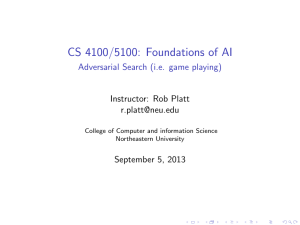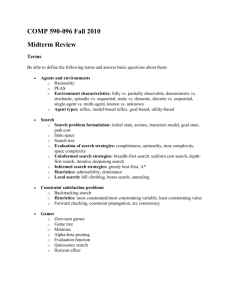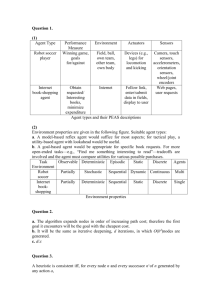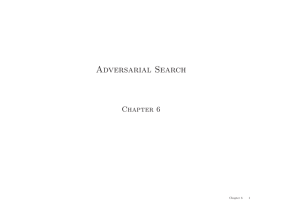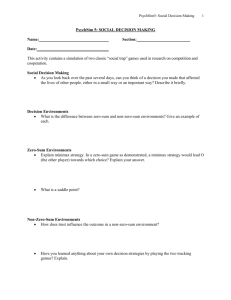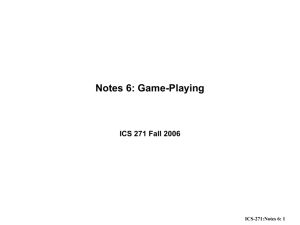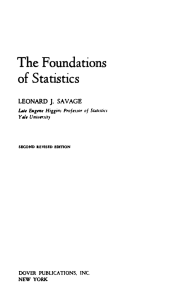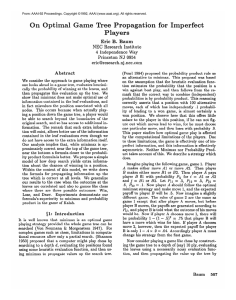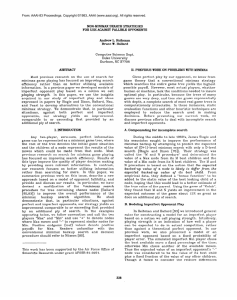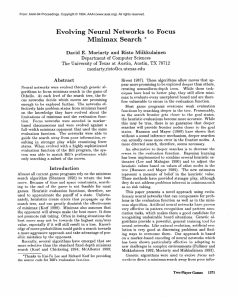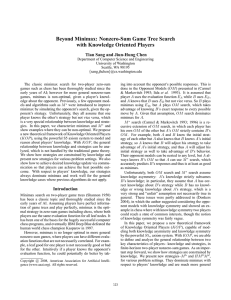Game-Playing MiniMax
advertisement
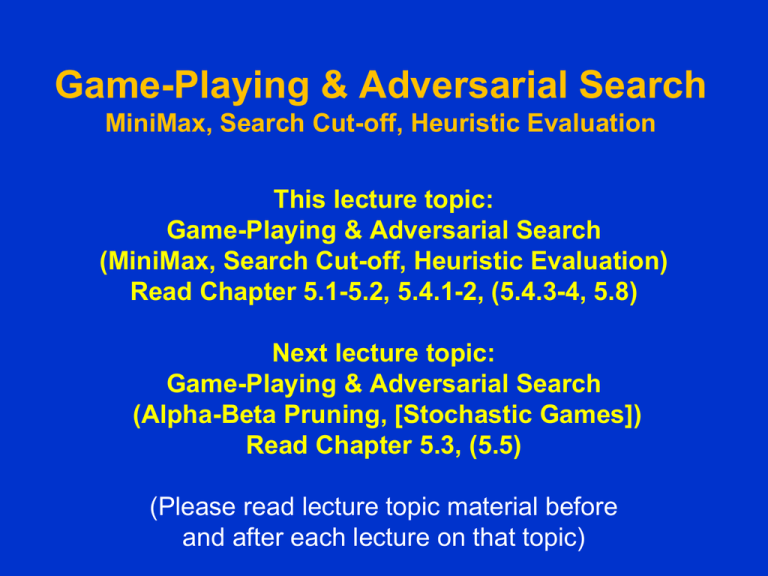
Game-Playing & Adversarial Search MiniMax, Search Cut-off, Heuristic Evaluation This lecture topic: Game-Playing & Adversarial Search (MiniMax, Search Cut-off, Heuristic Evaluation) Read Chapter 5.1-5.2, 5.4.1-2, (5.4.3-4, 5.8) Next lecture topic: Game-Playing & Adversarial Search (Alpha-Beta Pruning, [Stochastic Games]) Read Chapter 5.3, (5.5) (Please read lecture topic material before and after each lecture on that topic) You Will Be Expected to Know • Basic definitions (section 5.1) • Minimax optimal game search (5.2) • Evaluation functions (5.4.1) • Cutting off search (5.4.2) • Optional: Sections 5.4.3-4; 5.8 Types of Games battleship Kriegspiel Not Considered: Physical games like tennis, croquet, ice hockey, etc. (but see “robot soccer” http://www.robocup.org/) Typical assumptions • Two agents whose actions alternate • Utility values for each agent are the opposite of the other – This creates the adversarial situation • Fully observable environments • In game theory terms: – “Deterministic, turn-taking, zero-sum, perfect information” • Generalizes: stochastic, multiple players, non zero-sum, etc. • Compare to, e.g., “Prisoner’s Dilemma” (p. 666-668, R&N) – “NON-turn-taking, NON-zero-sum, IMperfect information” Game tree (2-player, deterministic, turns) How do we search this tree to find the optimal move? Search versus Games • Search – no adversary – Solution is (heuristic) method for finding goal – Heuristics and CSP techniques can find optimal solution – Evaluation function: estimate of cost from start to goal through given node – Examples: path planning, scheduling activities • Games – adversary – Solution is strategy • strategy specifies move for every possible opponent reply. – Time limits force an approximate solution – Evaluation function: evaluate “goodness” of game position – Examples: chess, checkers, Othello, backgammon Games as Search • Two players: MAX and MIN • MAX moves first and they take turns until the game is over – Winner gets reward, loser gets penalty. – “Zero sum” means the sum of the reward and the penalty is a constant. • Formal definition as a search problem: – – – – – – • Initial state: Set-up specified by the rules, e.g., initial board set-up of chess. Player(s): Defines which player has the move in a state. Actions(s): Returns the set of legal moves in a state. Result(s,a): Transition model defines the result of a move. Terminal-Test(s): Is the game finished? True if finished, false otherwise. Utility function(s,p): Gives numerical value of terminal state s for player p. • E.g., win (+1), lose (-1), and draw (0) in tic-tac-toe. • E.g., win (+1), lose (0), and draw (1/2) in chess. MAX uses search tree to determine “best” next move. An optimal procedure: The Min-Max method Will find the optimal strategy and best next move for Max: • 1. Generate the whole game tree, down to the leaves. • 2. Apply utility (payoff) function to each leaf. • 3. Back-up values from leaves through branch nodes: – a Max node computes the Max of its child values – a Min node computes the Min of its child values • 4. At root: Choose move leading to the child of highest value. Two-ply Game Tree Two-Ply Game Tree Two-Ply Game Tree Two-Ply Game Tree Minimax maximizes the utility of the worst-case outcome for Max The minimax decision Pseudocode for Minimax Algorithm function MINIMAX-DECISION(state) returns an action inputs: state, current state in game return arg maxaACTIONS(state) MIN-VALUE(Result(state,a)) function MAX-VALUE(state) returns a utility value if TERMINAL-TEST(state) then return UTILITY(state) v −∞ for a in ACTIONS(state) do v MAX(v,MIN-VALUE(Result(state,a))) return v function MIN-VALUE(state) returns a utility value if TERMINAL-TEST(state) then return UTILITY(state) v +∞ for a in ACTIONS(state) do v MIN(v,MAX-VALUE(Result(state,a))) return v Properties of minimax • Complete? – Yes (if tree is finite). • Optimal? – Yes (against an optimal opponent). – Can it be beaten by an opponent playing sub-optimally? • No. (Why not?) • Time complexity? – O(bm) • Space complexity? – O(bm) (depth-first search, generate all actions at once) – O(m) (backtracking search, generate actions one at a time) Game Tree Size • Tic-Tac-Toe – b ≈ 5 legal actions per state on average, total of 9 plies in game. • “ply” = one action by one player, “move” = two plies. – 59 = 1,953,125 – 9! = 362,880 (Computer goes first) – 8! = 40,320 (Computer goes second) exact solution quite reasonable • Chess – b ≈ 35 (approximate average branching factor) – d ≈ 100 (depth of game tree for “typical” game) – bd ≈ 35100 ≈ 10154 nodes!! exact solution completely infeasible • It is usually impossible to develop the whole search tree. (Static) Heuristic Evaluation Functions • An Evaluation Function: – Estimates how good the current board configuration is for a player. – Typically, evaluate how good it is for the player, how good it is for the opponent, then subtract the opponent’s score from the player’s. – Often called “static” because it is called on a static board position. – Othello: Number of white pieces - Number of black pieces – Chess: Value of all white pieces - Value of all black pieces • Typical values : – -infinity (loss) to +infinity (win) or [-1, +1] or [0, +1]. • Board evaluation X for player is -X for opponent – “Zero-sum game” (i.e., scores sum to a constant) Applying MiniMax to tic-tac-toe • The static heuristic evaluation function: Minimax Values (two ply) Iterative (Progressive) Deepening • In real games, there is usually a time limit T to make a move • How do we take this into account? • Using MiniMax we cannot use “partial” results with any confidence unless the full tree has been searched – So, we could be conservative and set a conservative depthlimit which guarantees that we will find a move in time < T • Disadvantage: we may finish early, could do more search • In practice, Iterative Deepening Search (IDS) is used – IDS runs depth-first search with an increasing depth-limit – When the clock runs out we use the solution found at the previous depth limit – With alpha-beta pruning (next lecture), we can sort the nodes based on values found in previous depth limit to maximize pruning during the next depth limit => search deeper Heuristics and Game Tree Search: Limited horizon • The Horizon Effect – Sometimes there’s a major “effect” (e.g., a piece is captured) which is “just below” the depth to which the tree has been expanded – The computer cannot see that this major event could happen because it has a “limited horizon” --- i.e., when search stops – There are heuristics to try to follow certain branches more deeply to detect such important events, and so avoid stupid play – This helps to avoid catastrophic losses due to “short-sightedness” • Heuristics for Tree Exploration – – – – Often better to explore some branches more deeply in allotted time Various heuristics exist to identify “promising” branches Stop at “quiescent” positions --- all battles are over, things are quiet Continue when things are in violent flux --- the middle of a battle Selectively Deeper Game Trees Eliminate Redundant Nodes • On average, each board position appears in the search tree approximately ~10150 / ~1040 ≈ 10100 times. => Vastly redundant search effort. • Can’t remember all nodes (too many). => Can’t eliminate all redundant nodes. • However, some short move sequences provably lead to a redundant position. – These can be deleted dynamically with no memory cost • Example: 1. P-QR4 P-QR4; 2. P-KR4 P-KR4 leads to the same position as 1. P-QR4 P-KR4; 2. P-KR4 P-QR4 Summary • Game playing is best modeled as a search problem • Game trees represent alternate computer/opponent moves • Minimax is a procedure which chooses moves by assuming that the opponent will always choose the move which is best for them – Basically, it avoids all worst-case outcomes for Max, to find the best. – If the opponent makes an error, Minimax will take optimal advantage of that error and make the best possible play that exploits the error. • Cutting off search – In general, it is infeasible to search the entire game tree. – In practice, Cutoff-Test decides when to stop searching further. – Prefer to stop at quiescent positions. – Prefer to keep searching in positions that are still violently in flux. • Static heuristic evaluation function – Estimate quality of a given board configuration for the Max player. – Called when search is cut off, to determine value of position found.

